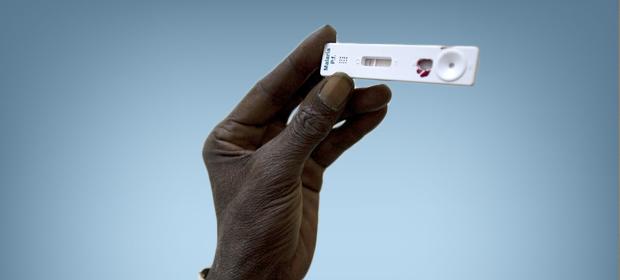Where We Work
See our interactive map


Last year, the World Malaria Report brought good news: a drop of 50% or more in the malaria burden in 11 African countries and in 32 of 56 malaria-endemic countries outside of Africa.* Enabling these countries, and others, to provide effective malaria prevention and treatment and move towards malaria elimination requires the consistent use of diagnostic tests to confirm suspected malaria cases prior to treatment; appropriate and timely treatment for confirmed malaria cases; and continued financial support for malaria control, including the use of insecticide-treated nets and residual spraying for mosquito control.
Senegal, where IntraHealth International supports malaria prevention and treatment, reported a 41% drop in malaria cases in late 2010. Such rapid improvements in malaria control globally, and in Senegal, can be attributed to better access to insecticide-treated mosquito nets for 76% of people at risk for malaria in sub-Saharan Africa; the expansion of insecticide residual spraying for mosquito control; and a sharp rise in international funding for malaria control in the past ten years.
In 2000, only 7% of Senegalese households reported having at least one insecticide-treated net, but by 2010 the number had risen to 57%; and many more pregnant women and children reported sleeping under a net. Senegal has also been quick to expand the availability of malaria diagnostic tools, enabling health workers there to discern and treat actual—rather than suspected—malaria cases and allowing for a more accurate understanding of the country’s malaria situation.
In the past, many malaria cases, especially among children younger than five years-old, were reported and treated by presumptive diagnosis based on a list of symptoms, most notably high fever. The World Health Organization now recommends a diagnostic test for suspected malaria cases prior to treatment. Now, with fewer malaria cases, there is great likelihood of over- or misdiagnosis, which can lead to unnecessary and expensive treatment regimes, failure to treat the underlying cause of the symptoms, and inaccurate malaria surveillance reports. Reserving treatment for confirmed malaria cases is not only cost-effective but also important for warding off potential drug resistance to the current therapies, by prescribing them only when necessary.
According to the World Malaria Report, until 2007 confirmatory malaria diagnosis was only available in hospitals in Senegal; and of the “1.5 million fever cases treated as malaria, only 3% were confirmed as malaria by microscopy.”† In the past few years, however, Senegal has been one of the few countries to push for rapid and widespread availability of malaria diagnostics.
As a part of this push, IntraHealth has collaborated with the Ministry of Health to train health workers in ten regions in basic microscopy malaria diagnosis such as how to assess parasite density and how to:
These training sessions have also provided new microscopes to laboratories around the country to continue this work. In 2007, Senegal also revised its national policy for management of febrile illness to introduce rapid diagnostic tests for malaria in all public health facilities beyond hospitals, including health centers, health posts, and health huts, resulting in an immediate drop in confirmed malaria cases and more appropriate use of anti-malarial medications.

Educating families and communities about the symptoms and dangers of malaria is an important first step in guaranteeing that people with malaria infections are quickly diagnosed and appropriately treated. In Africa, where malaria infections continue to be one of the leading causes of childhood deaths, families need to know to take children with a fever to a health center or community health worker as soon as possible.
In Senegal, IntraHealth is working with communities to educate people about preventing malaria, teach them how to recognize symptoms, and inform people—through community forums and events, public service announcements, and radio and television broadcasts—on where they can go for treatment. IntraHealth is also supporting the distribution of long-lasting, insecticide-treated nets.
* All global statistics and those for Senegal, not specific to IntraHealth International’s work, are taken from the 2010 World Malaria Report published by the World Health Organization Global Malaria Programme.



